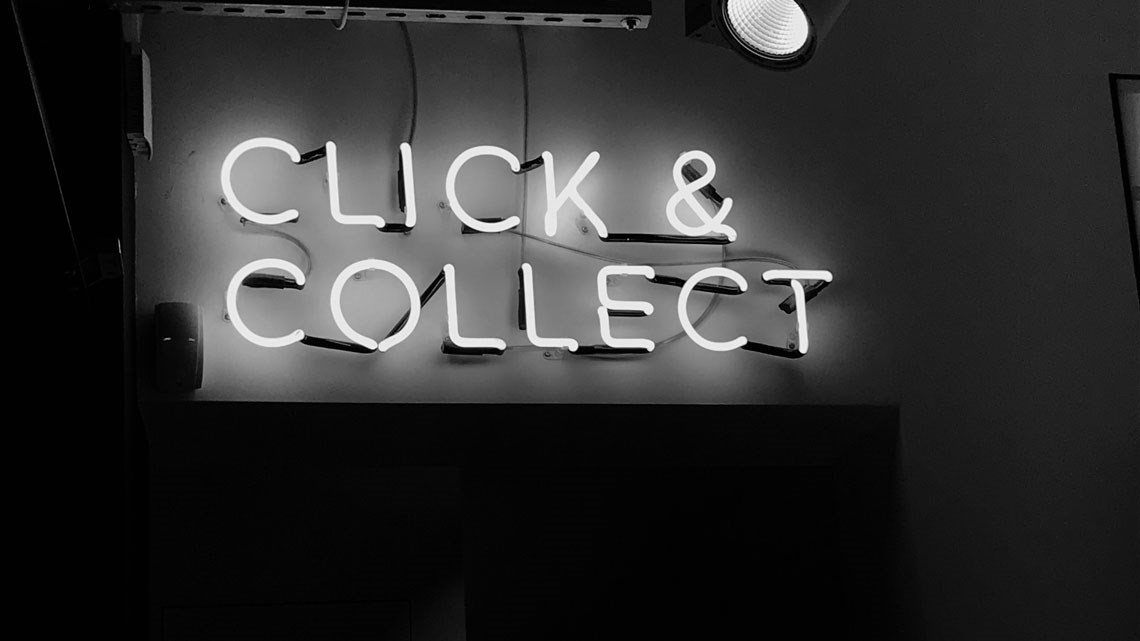
UX Lab - 10 tips for delivering a great Click & Collect experience
Click and Click, or Click and Reserve, is no longer the preserve of large supermarkets or department stores, in fact it is no longer the preserve of just retailers, with many B2B and trade suppliers now offering collection from trade counters, collection points or warehouses. It’s a great opportunity to add value and differentiate yourself from the competition, as shown by the success of our customer Longacres Garden Centres, who have introduced an innovative ‘drive thru’ Click and Collect service unrivalled by their competitors.
Click & Collect is now an essential part of a company's omni-channel armoury due to the increase in footfall, customer convenience and speed of fulfilment it can provide, with many companies reporting that over 25% of customers made additional purchases in store when collecting items. An opportunity like that is too good to miss, so in this insight we will look at 10 great tips to help you deliver a class-leading Click and Collect service, both online, and in-store.
1. Define internally how you are going to deliver it
When deciding to launch a Click and Collect/Reserve service it is vital to ensure that you define exactly how you are going to deliver it, what type of service you will provide and examine any pain points that could potentially arise. Some things to consider:
a) Type of Service
There are two obvious types to consider regarding whether the item is paid for at the point of ordering or when the items are collected. Here are the advantages of each:
Pay online, collect in store (Click and Collect)
This ensures that you are paid for items and users don't change their mind or don't turn up to collect goods, particularly if they have been specifically shipped to store or removed from shelves when they could have been sold to other customers.
Reserve online, pay and collect in store (Click and Reserve)
This provides an even quicker online checkout process as the customer doesn't need to enter any payment details before checking out. There is also a greater chance they will add to their order in-store as they won't need to do another separate transaction once they collect their goods.
b) Integrations/Stock Fulfilment
The next thing to consider is where the orders will be fulfilled from. They could either come from a central warehouse meaning items are shipped to the relevant store for collection on a scheduled date (this would have a time delay whilst items are sent, or they could be added to regular store deliveries depending on the frequency of them), or directly from individual store stock where orders could be fulfilled quickly (often within an hour or two). Some merchants also provide a combination of these two services with store stock being free to collect, whilst items that require delivery to store incur a charge. Which service you are able to offer may well be dictated by how your stock is managed, how your third party systems are tied together (can your stock management/ERP system and ecommerce platform talk to each other?), volume of stock held (both centrally and in stores), number of warehouses, physical room for additional stock at stores etc…
c) Returns
Returns add another lay of complexity and you need to define exactly how you manage them. In the omni-channel age, your customers don’t think of your website and stores separately (you are a single company) so you should allow Click & Collect orders to be returned to any of your stores or via post/courier. This may be quite complicated to manage but your customers will want this.
d) Assigning sales internally
In order to avoid any potential problems with internal channel conflict, you may need to define whose sales number a Click and Collect/Reserve order will be assigned to. Depending on the size of your company and how sales are reported, they may be assigned to the ecommerce team or the individual store or stores, or to the entire retail business? There are many things to consider like, what if all online orders are assigned to the ecommerce team regardless of fulfilment type and the customer buys additional items when in-store? Who do those sales get assigned to and how do your report on them? There is no right or wrong solution but it’s important to define how this will be managed from the outset and ensure it is communicated to all affected staff.
2. Promote the service and explain how it works
As with any service, it is no good introducing it and ensuring it runs perfectly, if nobody knows about it, so ensuring it is well marketed and advertised is key, not only across your website, but across your other channels too – emails, direct mail, advertising, store estate, catalogues etc…
As mentioned above, not all Click and Collect services are the same, so explaining the exact process of how yours works is also important. It’s better to provide the customer with too much information than too little, so ensure you explain where they need to go, what they need to bring, how they can pay if they haven’t paid online, how long items are held for, how to get in touch if there is a problem etc…
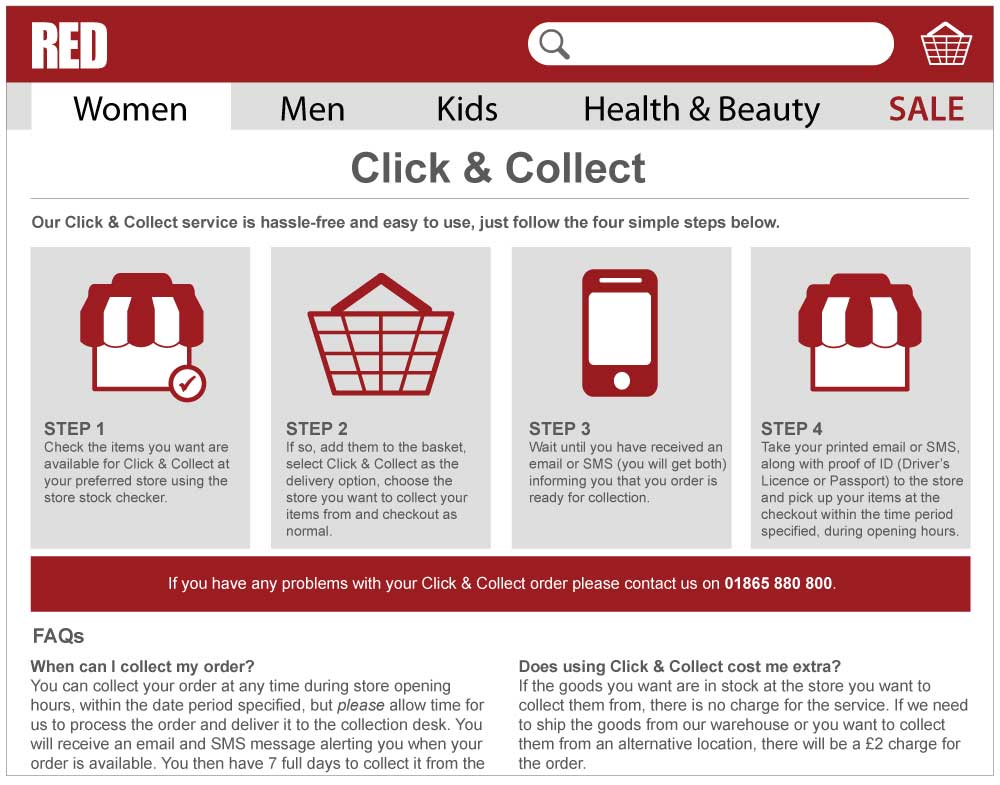
Example page explaining Click and Collect service with FAQs
3. Offer a store stock checker
Delivering Click and Collect is great but in order to compliment the service display live stock levels of in-store products for each individual item. This can show customers whether the item they want is available at their local store, or one nearby, meaning they don’t waste time going through the checkout only to find the item they want to collect is not available. By providing a buffer level on each item, at each store, you can ensure that there is some allowance for sudden large in-store purchases or more popular items and stores. Ensuring that your ecommerce platform and warehouse management/ERP software are integrated is crucial in being able to provide this service alongside your Click and Collect. Retailers like F.Hinds show real-time stock levels on every product at every store, as well as their online inventory.
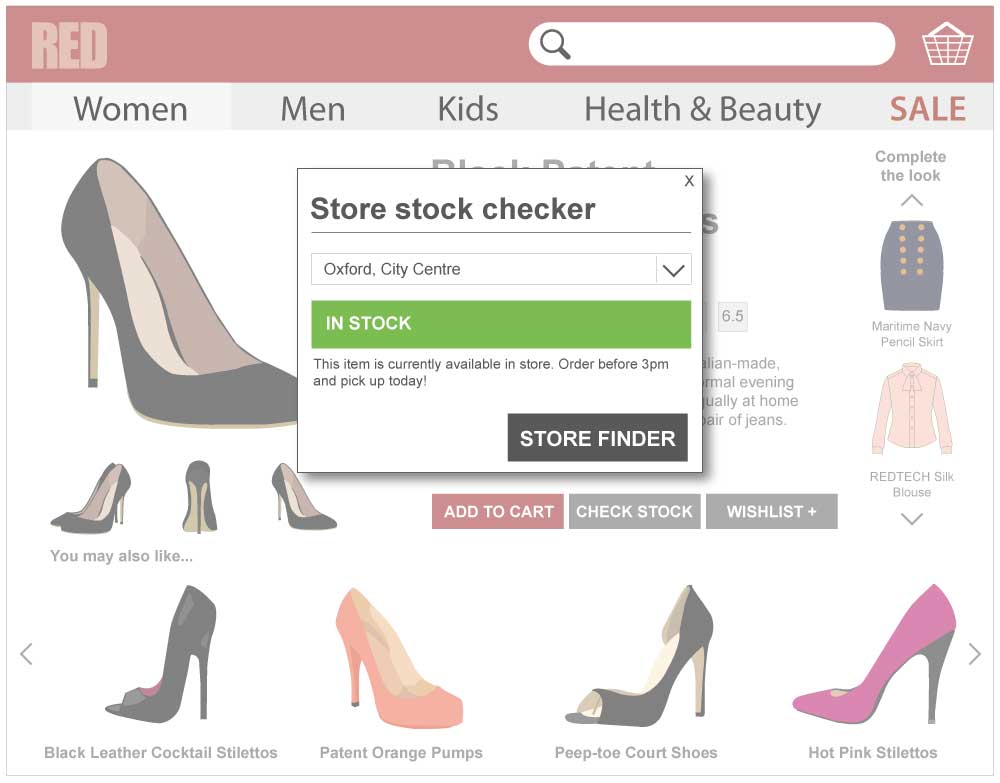
Example store stock checker on product pages
4. Use a store locator
Ensure that your website displays details of all of the stores where customers can collect their items. A store locator on your website should give the address (including additional postcode/information for Sat Navs if different), contact number & opening hours (including regularly updated seasonal hours if appropriate). tradeit features permission based administration, meaning local stores can be given control of store pages to highlight in-store events, promotions or opening hours outside of the norm.
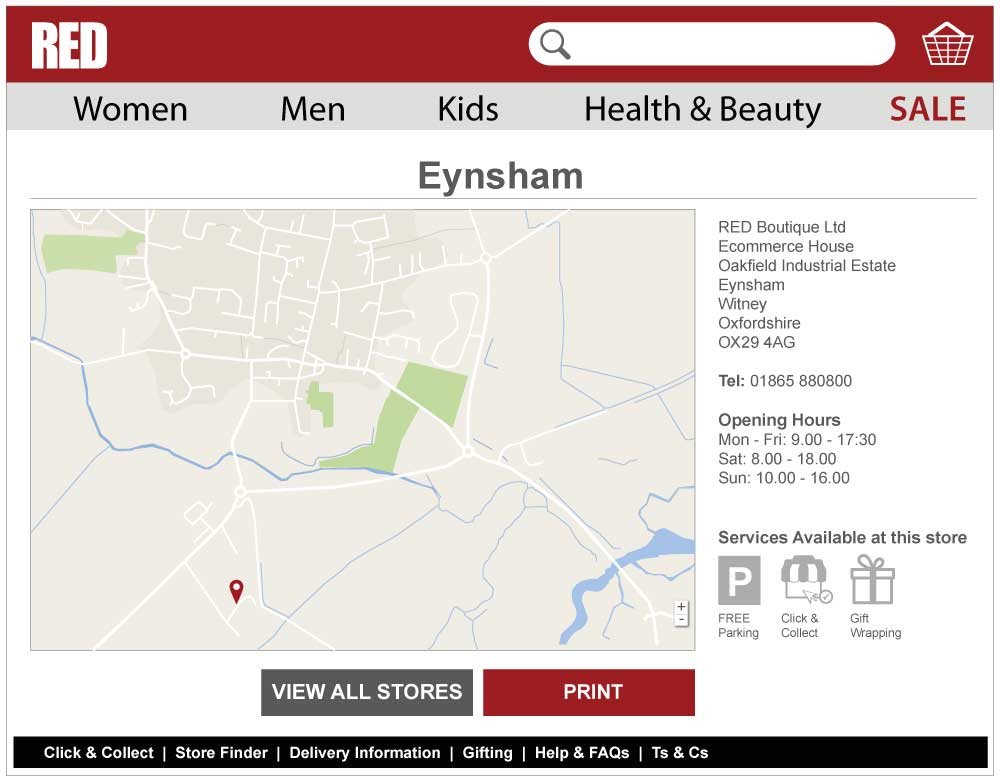
Example of a typical store locator page
5. Ensure it functions on mobile devices
With the growth of responsive web design and omni-channel consumers, ensuring your service is the same across all touchpoints and devices is vital. If you are in the position of being able to offer quick collections from retail store stock then making sure that this service is available via mobile devices can cater for buyers and showroomers on the move.
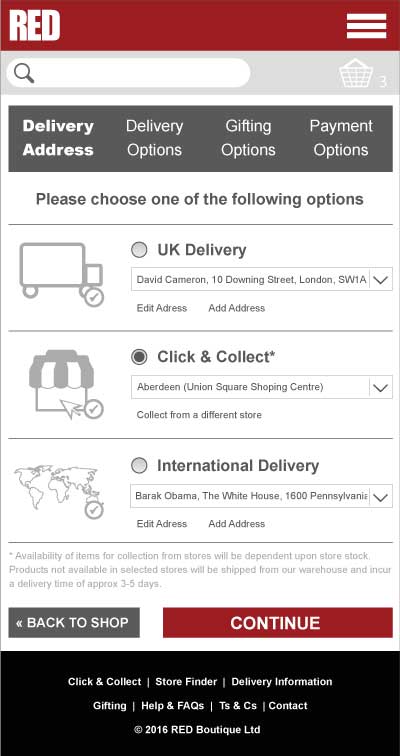
Example mobile checkout showing Click and Collect
6. Offer other collection options besides your own retail stores
You may not have that many stores or they may not be in the most convenient location for all of your customers, so offering users the chance to collect from other locations (like post offices, secure lockers or convenience stores) is a great way of expanding the reach and opening hours of your Click & Collect service without a vast store estate, and providing your customers with an additional fulfilment option. Even at an additional cost, they may well be willing to pay for the added convenience of collecting it at a time more convenient to them and at a location closer than one of your retail stores or collection points.
7. Display all fulfilment options
If you don't offer all items for Click and Collect, make sure that you display all of the fulfilment options available on each product once added to the basket and/or on each individual product page, rather than making the user go through the entire checkout process before discovering an item is not eligible for Click and Collect. To avoid these problems you should endeavour to offer as much as you can for Click & Collect and only not offer it on items when it is completely impractical or impossible. By using Click & Collect in conjunction with Endless Aisle you can extend the reach of your stock meaning orders can be fulfilled from other stores or central inventory, for customer collection.

Example checkout showing fulfilment options for each line item
8. Ensure regular contact with the customer once their order has been placed
Make sure that you communicate exactly what is happening with their order to the customer so that they know when and where they should collect it, (email and SMS messages are most effective methods – but don’t charge for the provision of SMS updates) and what they need to bring with them in order to verify that it is theirs (proof of ID, card they ordered with, receipt/email/reference number) and they can collect it without a problem. Ensure this information is displayed on all communications and there is a section on your website outlining this again.
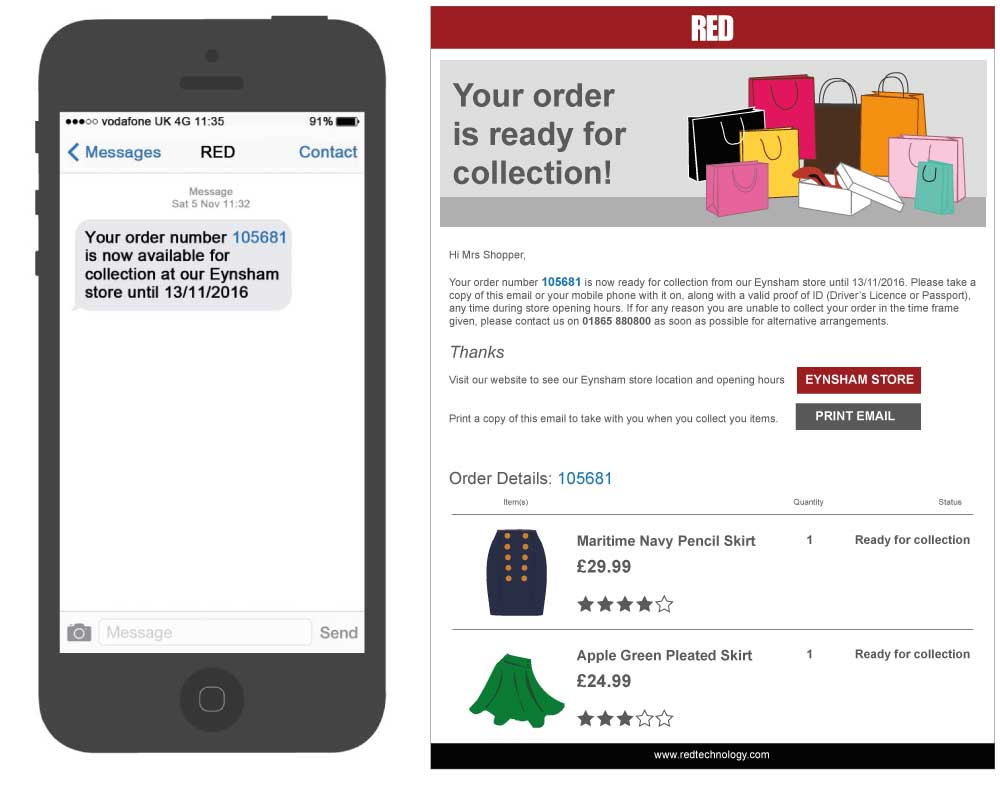
Example SMS and Email communications
The worst scenario is for the customer to go out of their way to collect an order, only to find that you don’t have it and it’s not ready for them to collect, especially if you have told them it is. Not only that, if you are offering time-specific Click and Collect services like collection within an hour of ordering ensure that those expectations are met. If you can’t meet them, don’t offer them or give yourself more leeway to ensure you can. Lastly, make sure that you communicate the exact opening and closing times of any stores (and the Click and Collect collection points if they differ), in case they arrive early or are running late.
9. Don't charge for the service
If your customers are collecting it from one of your own retail stores, don’t charge them. Statistics show that the average Click and Collect customer spends an additional £27 in store when they pick up their items, so any potential money it may cost you to fulfil the orders, should be offset by increases in revenue. If you are fulfilling all Click and Collect orders from a central location and shipping them to individual stores, there is obviously a temptation to charge for this service, but try to resist. A customer would argue that if they are going to your store to collect items, particularly if they can check the stock of them online, they might as well buy them off the shelf, and not pay to collect them. For an omni-channel business, any chance to drive customers to stores or collection points should be taken, so don’t charge. By allowing customers to collect items and see them or try them on before leaving the store, you can also reduce return rates.
If you really do feel it’s necessary to charge for Click and Collect services it may pay to alter the cost around peak periods dependent on the time and day of the week, like supermarkets do with home delivery services. This may help drive footfall to stores at less busy times. It might also make sense to offer the service for free over a certain amount (i.e. FREE over £50).
If you offer additional pick-up locations, outside of your own retail stores, then it’s reasonable to charge for this, and most customers wouldn’t expect it for free, but try to keep the cost to a minimum so as to encourage the take up of such services.
10. In-store collection
No matter whether you are large or small, B2B or retail, the customer experience should be equally as good at your stores or collection points, as it should be online. It’s no use having a really slick and efficient online experience that falls apart once the customer goes to collect their order, so here are some things to consider about the in-store service:
1) As we’ve discussed above, ensure the customer knows where your store/collection point is, what time it opens and closes, and when they can collect their order. Nobody wants to turn up to collect an item when your store is shut or your collection point is closed.
2) Ensure customers know exactly where to go and what to do once they have reached your store. If you have a larger store, a designated area for Click and Collect items might be appropriate.
3) Highlight where your collection point is with instructions/directions and possibly an in-store map for larger stores. Also make sure that any in-store signage and directions are clear. Even if you have small stores, make sure you communicate where they should go, even if it is just to the till and seems obvious.
4) Make sure customers don’t have a lengthy wait. At Christmas time (the most busy period for retailers offering Click & Collect services), it might make sense to have timed collection slots to ensure an even distribution of collections throughout the day. For B2B services like builder’s merchants where collections are more likely to be made at the very start or very end of the day, you may need to assign extra staff for Click & Collect orders at these times. In these cases it may pay to extend the opening hours of the collection point above and beyond when the rest of the business operates.
Red Technology delivers class-leading, omni-channel retail ecommerce services including Click & Collect solutions for leading retailers like Pets Corner, Calendar Club, and F. Hinds, as well as the innovative 'Drive Thru' Click & Collect at Longacres Garden Centres. For more information about our Click and Collect solutions contact us.






